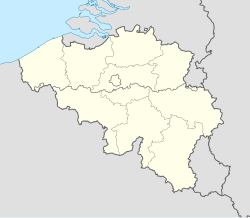Top Qs
Timeline
Chat
Perspective
Saint-Josse-ten-Noode
Municipality of the Brussels-Capital Region, Belgium From Wikipedia, the free encyclopedia
Remove ads
Saint-Josse-ten-Noode (French, pronounced [sɛ̃ ʒɔs tœn nod] ⓘ) or Sint-Joost-ten-Node (Dutch, pronounced [sɪɲˌtɕoːstɛˈnoːdə] ⓘ), often simply called Saint-Josse in French or Sint-Joost in Dutch, is one of the 19 municipalities of the Brussels-Capital Region, Belgium. Located in the north-eastern part of the region, it is bordered by the City of Brussels and Schaerbeek.
As of 1 January 2022[update], the municipality had a total population of 26,965.[3] The total area is 1.16 km2 (0.45 sq mi), which gives a population density of 23,234/km2 (60,180/sq mi).[3] From a total of 581 municipalities in Belgium, Saint-Josse is both the smallest in area size and the most densely populated. In common with all of Brussels' municipalities, it is legally bilingual (French–Dutch).
Remove ads
History
Summarize
Perspective

Named after Saint Judoc, Saint-Josse was originally a farming village on the outskirts of Brussels. In the centuries before the dismantling of the ramparts encircling Brussels, Saint-Josse was also the place where noblemen built country estates, the most notable amongst them the Castle of the Dukes of Brabant built by Philip the Good in 1456. The area surrounding that castle was planted with wine groves, which explains the presence of the bushel of grapes in the municipality's coat of arms.[4]
After the demolition of the ramparts, Saint-Josse was one of the first areas outside Brussels to urbanise. The rich built houses around the new boulevards and higher parts of the municipality, while industries and workman's cottages were built in the lower lying part close to the river Senne. In 1855, 58% of the land area of Saint-Joose was annexed by the municipality of the City of Brussels to make way for the Square Ambiorix/Ambiorixsquare, the Square Marguerite/Margaretasquare, the Square Marie-Louise/Maria-Louizasquare and the Avenue Palmerston/Palmerstonlaan of the newly created Leopold Quarter (now the European Quarter).[4]
According to an inventory of architecture commissioned by the Brussels Region, Saint-Josse has on average the oldest buildings of all 19 Brussels municipalities.[5]
Remove ads
Demographics
While foreigners were a majority in 1995, in 2007 most of the population had Belgian citizenship, which has resulted in a sharp increase of municipal councillors with a foreign background, benefitting from the open proportional electoral system: from none in 1988 to two (from Morocco) in 1994, a near majority of 13 (seven from Morocco, five from Turkey) out of 27 in 2000 (including three aldermen) and a majority of 20 out of 27[6] in 2007 (including six aldermen out of seven, the seventh is a member of the Flemish minority[7]).
Remove ads
Politics
Mayors
Historical list of mayors or burgomasters of Saint-Josse:[9]
- 1800–1808: André-Etienne-Joseph O'Kelly
- 1808–1813: Jacques-Joseph De Glimes (GLIM)
- 1813: Théodore-Nicolas-Joseph Aerts 1813
- 1813–1823: Jean-François Wauvermans
- 1823–1842: Urbain Henri Verbist
- 1842–1846: Léonard Constant Willems
- 1846–1867: Jacques Joseph Damas Gillon
- 1867–1870: Louis Guillaume Felix Sainctelette
- 1870–1884: Fritz Jottrand
- 1885–1899: Armand Steurs
- 1900–1926: Henri Frick
- 1926–1942: Georges Petre (alderman, then mayor from 1926 until his destitution and assassination by the Rexists in 1942)
- 1944–1947: Joseph Dery
- 1947–1953: André Saint-Remi
- 1953–1999: Guy Cudell
- 1999–2012: Jean Demannez (councillor in 1976, alderman in 1977, mayor in 1999, reelected in 2000 and 2006)
- 2012–present: Emir Kir
Culture
- The Charlier Museum is devoted to Belgian art of the end of the 19th century.[10]
- The Jazz Station is a museum and archive on jazz, and a venue for jazz concerts.[11]
References
External links
Wikiwand - on
Seamless Wikipedia browsing. On steroids.
Remove ads






